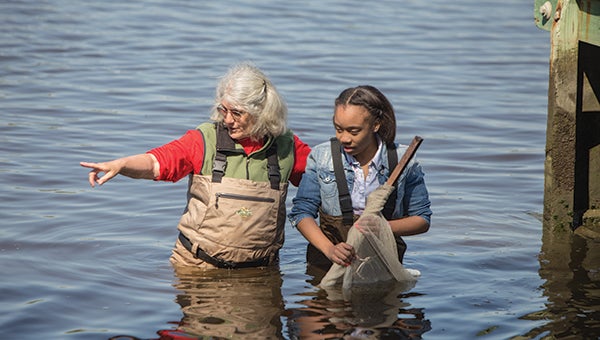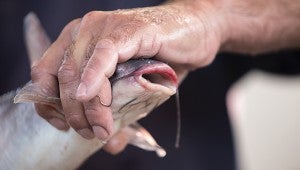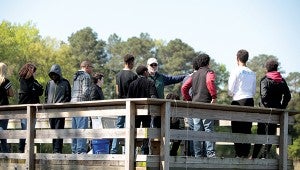Restoring the river
Published 1:22 pm Tuesday, May 19, 2015

A Nansemond River Preservation Alliance volunteer helps a Suffolk middle school student stretch a seine net across the boat ramp at Bennett’s Creek Park during a recent educational event there. Educating youngsters about what lives in the water is a crucial first step toward teaching them to be more aware of how their activities affect the water quality of Suffolk’s rivers and creeks.
Group works to clean up the Nansemond
The Nansemond River is in trouble.
Bacteria levels have resulted in the closure of huge portions of both the Upper and Lower Nansemond to shellfish harvesting, and its tributaries — Bennett’s, Bleakhorn and Knott’s creeks — are under a similar condemnation order by the Virginia Department of Health. Phosphorous levels far exceed the point at which algae blooms can grow, and water clarity is poor.
But the river has an advocate now in the Nansemond River Preservation Alliance, and those who love the Nansemond — and, by extension, Suffolk’s other waterways — now have reason to hope things will improve.

Yancey Powell, the Hampton Roads education manager for the Chesapeake Bay Foundation, shows students from Forest Glen Middle School a blue catfish taken from the mouth of the Nansemond River during a recent educational boat trip. Blue cats are an introduced species that has become prevalent in area waterways.
In fact, the NRPA, founded in 2009 by a group of 14 citizens who lived alongside or had interests in the river, is the reason anybody even knows the extent of the waterways’ pollution problems.
To folks just passing over one of Suffolk’s bridges, “it doesn’t look condemned to people, and that’s the problem,” says John Wass, NRPA’s treasurer and co-chairman of some of its committees.
But the organization has been conducting tests along the river for a couple of years now, and the work of its more than 200 volunteers has helped identify the true state of the waterway, as described most recently in its “2014 State of the Nansemond River and Its Tributaries Report,” which contains results and analysis of two years worth of water sampling data.
“The river reflects the quality of life here in Suffolk,” says Executive Director Elizabeth Taraski, sitting at a conference table in the alliance’s one-room office in the C.E. & H. Ruritan Club building in Eclipse. The room is cluttered with river maps and surveys, photos and artwork depicting life in this waterfront community and cabinets filled with educational and testing equipment.
“Everyone wants healthy waterways,” Taraski says.
The problem is that it’s easier to get unhealthy waterways, and once they’ve been polluted, it’s very hard — maybe even impossible — to restore them to full health.

Middle school students learn by land and by sea — and by pier — in the Nansemond River Preservation Alliance’s educational programs.
When the dam was built that created Lake Meade at the head of the Nansemond, for example, nobody realized one effect would be to reduce the flow of the river and thereby limit the Nansemond’s ability to flush out pollutants, so animal and pet waste, faulty septic systems and the hard-to-pinpoint “non-point source” pollutants that wind up in the waterway are not as readily cleared as they were before the dam was built. And when heavy rainfall from hurricanes, nor’easters and other weather events gets added to the mix, things can go from bad to worse, Taraski explains.
So a big part of cleaning up the Nansemond is working to reduce the potential impact of those non-point source contaminants. That means diligently enforcing septic tank cleanout and shoreline encroachment regulations, cutting back on the use of fertilizers, picking up and disposing of pet waste and making sure the only thing that goes into storm drains is rainwater.
Accomplishing those goals requires educating the public about the goals and what can be done to achieve them, and that education is a big part of NRPA’s mission.
“We educate people to take care of their shoreline,” Taraski says. “We’ve been teaching people that we have a problem here.”
A big part of the educational effort takes place in Suffolk’s schools, where Taraski and other NRPA volunteers have been carrying out a program that includes classroom time, boat trips and hands-on shoreline activities designed to help middle-school students understand the importance of the river’s ecosystem and to recognize how susceptible that ecosystem is to pollution. More than 2,000 students have taken part in the program so far.
“Our 2,000 students who have been through our program know that if you put anything in the storm drain, it goes right to the waterway,” she says by way of example. “We’re really focused on helping the next generation.”
Members also take a direct approach to improving the river’s health through a program of oyster replenishment and buffer restoration along various parts of the river.
One adult oyster filters 50 gallons of water a day, Taraski explains, so planting the bivalves in areas of the river that have been condemned will help those areas rebound more quickly. Planting marsh grasses in shoreline areas at Bennett’s Creek Park and other parts of the city also helps filter the runoff into the river.
“It’s the cheapest way to keep your water clean,” Wass says, and he and others hope the cumulative effects of the restoration projects and educational programs will make a real difference in the health of the Nansemond.
Whether in North Suffolk or downtown, Taraski adds, “The river that binds us is the Nansemond River. It’s everyone’s responsibility to help protect and restore our waterways.”
For more information about the NRPA and how you can help restore the river, visit www.nansemondriverpreservationalliance.org.






